When it comes to restoring a space after water damage, isn't it fascinating how the right tools can make all the difference? You might underestimate the importance of professional equipment, but without it, efficiency and effectiveness can plummet. High-capacity dehumidifiers and specialized air movers are just the tip of the iceberg. Understanding how these advanced tools work together not only improves the restoration process but likewise safeguards your property from further issues. What exactly separates professional-grade equipment from the ordinary, and why should you care?
Importance of Professional Equipment
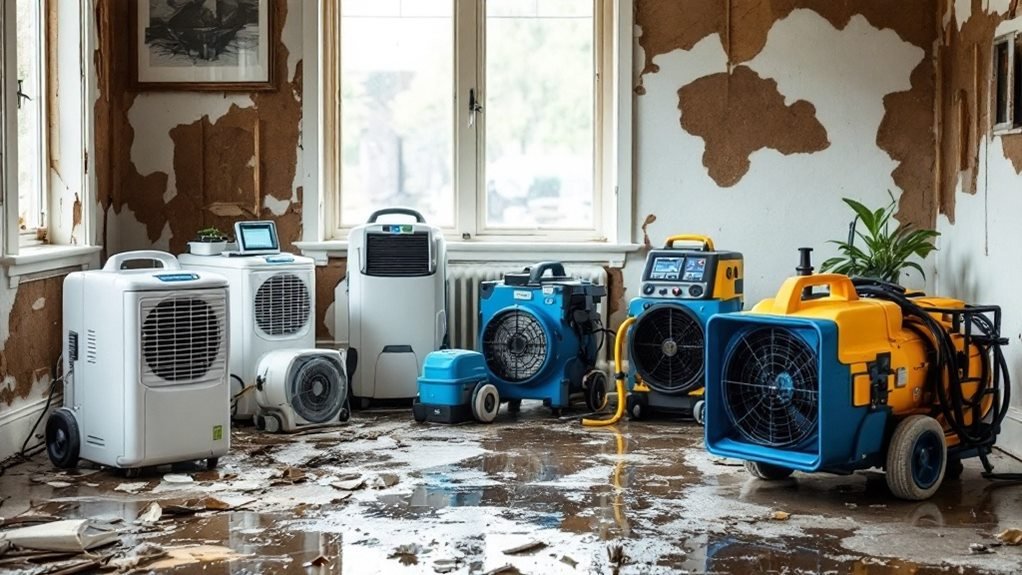
When it comes to water damage restoration, having the right equipment makes all the difference in achieving effective results. You might think a bucket and mop could do the trick, but let's face it—this isn't your average spill. A benefits overview of professional equipment reveals that advanced tools, like high-capacity dehumidifiers and powerful extraction units, can greatly reduce drying time and minimize damage.
Equipment advances have taken restoration to a new level, allowing you to tackle situations that would leave a DIY-er in despair. For instance, infrared moisture meters help you pinpoint hidden water pockets, ensuring you don't miss that sneaky leak behind the wall. Plus, using specialized air movers aids in circulating air while keeping mold at bay—a double whammy!
Investing in professional-grade equipment isn't just about showing off; it's about efficiency and effectiveness. Think of it as your superhero toolkit, ready to save the day from the villainous grasp of water damage. So, the next time you face a soggy situation, remember: your trusty mop just can't compete with the power of professional equipment!
Types of Water Damage
Understanding the various types of water damage is crucial for effective restoration. You've got to know what you're dealing with before you call in the cavalry—or the restoration team, that is. Water damage can typically be classified into three categories based on flood sources: clean water, gray water, and black water.
Clean water comes from those innocent culprits, like a burst pipe or a leaking sink. It's usually harmless—until it becomes a breeding ground for mold! Gray water, on the other hand, is a tad more troublesome, often coming from appliances like dishwashers or washing machines. It's not quite toxic, but it's best to treat it with caution—or at least a pair of rubber gloves. Then there's black water, the villain of the story, which includes sewage and floodwater. Think of it as the drama queen of water damage—best left to the pros.
Understanding this damage classification allows you to respond appropriately and minimize the chaos. So, whether it's a minor leak or a major flood, knowing the type of water damage at hand can save you from a real mess—both literally and figuratively!
Key Tools for Restoration
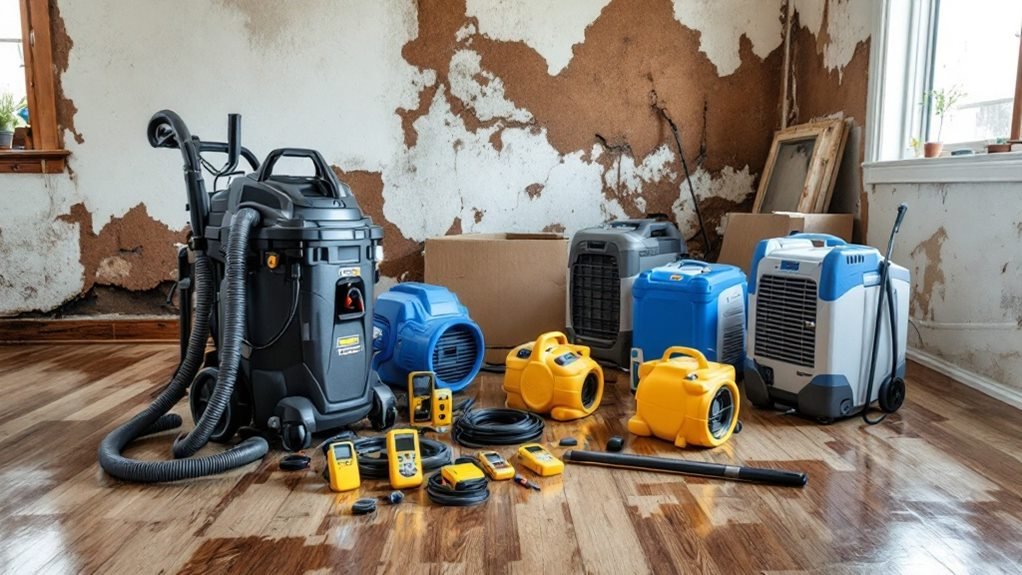
Effective water damage restoration relies heavily on the right tools. You can't just waltz in with a mop and bucket and hope for the best. First up, you'll need high-powered water extraction vacuums. These beasts suck up water faster than your neighbor's gossip spreads! Next, industrial air movers and dehumidifiers come into play, drying surfaces like a sauna on steroids.
When it comes to restoration techniques, having the right equipment is essential. Don't forget about floor drying systems, which help prevent mold from crashing the party. You'll additionally want to keep a few specialty tools handy, like moisture meters and infrared cameras, which are great for spotting hidden moisture.
Now, let's talk about equipment maintenance. Just like you wouldn't drive a car with a flat tire, you shouldn't attempt restoration with faulty gear. Regular checks and servicing of your equipment can save you time and headaches down the line. So, keep your tools in top shape, and you'll be ready to tackle any water disaster that comes your way—without needing a superhero cape.
Moisture Detection Equipment
A variety of moisture detection equipment is crucial for accurately evaluating water damage in any restoration project. Without these tools, you might as well be searching for a needle in a haystack—or worse, a soggy sock under the couch! Here are a few key pieces of equipment you should consider:
- Moisture Meters: These handy devices help you measure moisture levels in walls, floors, and other surfaces. They're like the detectives of the water world, always on the case!
- Thermal Imaging Cameras: These high-tech gadgets let you visualize temperature differences, revealing hidden moisture that's playing hide and seek. Think of them as the superhero sidekick for your moisture meter.
- Hygrometers: These tools measure humidity levels in the air, giving you a clearer picture of the overall moisture situation. It's like having an umbrella handy, but for your restoration project.
Air Movers and Dehumidifiers
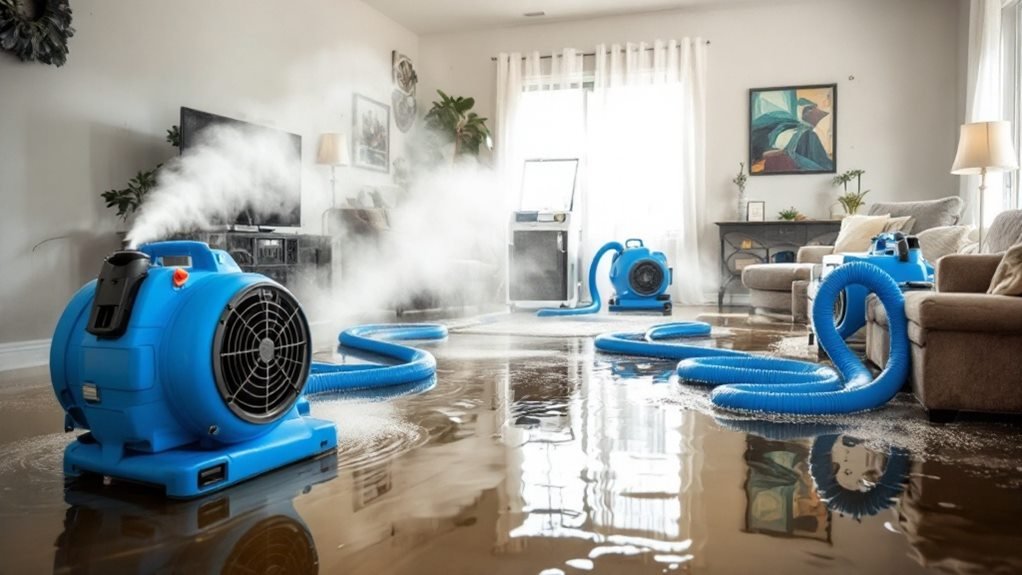
Once you've assessed the moisture levels with your detection equipment, the next step in the water damage restoration process involves managing airflow and humidity. This is where air movers and dehumidifiers strut their stuff like the stars of a reality show—only without the drama.
Air movers work by directing airflow to evaporate excess moisture from surfaces, while their efficiency plays a crucial role in speeding up the drying process. You want to position these handy machines strategically, ensuring they create a dynamic airflow. Think of it as a performance floor—everyone needs room to groove!
Dehumidifiers come to the rescue by pulling moisture from the air, effectively reducing humidity levels. Their capacity determines how quickly they can handle the water vapor in the space. So, you'll want to choose a dehumidifier that matches the area's size and moisture conditions—no one wants a dehumidifier that's out of its league!
Together, air movers and dehumidifiers form an unbeatable duo in drying out your space, ensuring you're not left with a soggy mess. Remember, effective restoration is all about teamwork—just like a good buddy cop movie!
Water Extraction Methods
When it comes to tackling water damage, selecting the right water extraction methods is crucial for swift and efficient recovery. You've got to make sure that you're employing effective suction techniques to maximize extraction efficiency. Otherwise, that pesky water might just decide to stick around like an uninvited guest.
Here are three common water extraction methods you might consider:
- Truck-mounted systems: These beasts of burden offer powerful suction capabilities, making them a favorite among professionals.
- Portable extractors: Perfect for tight spaces, these compact machines pack a punch and can be maneuvered with ease.
- Wet/dry vacuums: Don't underestimate these handy devices. They're great for small spills and can handle a range of messes, from water to the occasional snack crumb.
Whichever method you choose, remember that timing is everything. The sooner you act, the better your chances of preventing further damage. So, roll up your sleeves, grab that equipment, and let's kick that water to the curb! After all, you've got a home to save and a dry future to secure.
Sanitization and Disinfection Tools
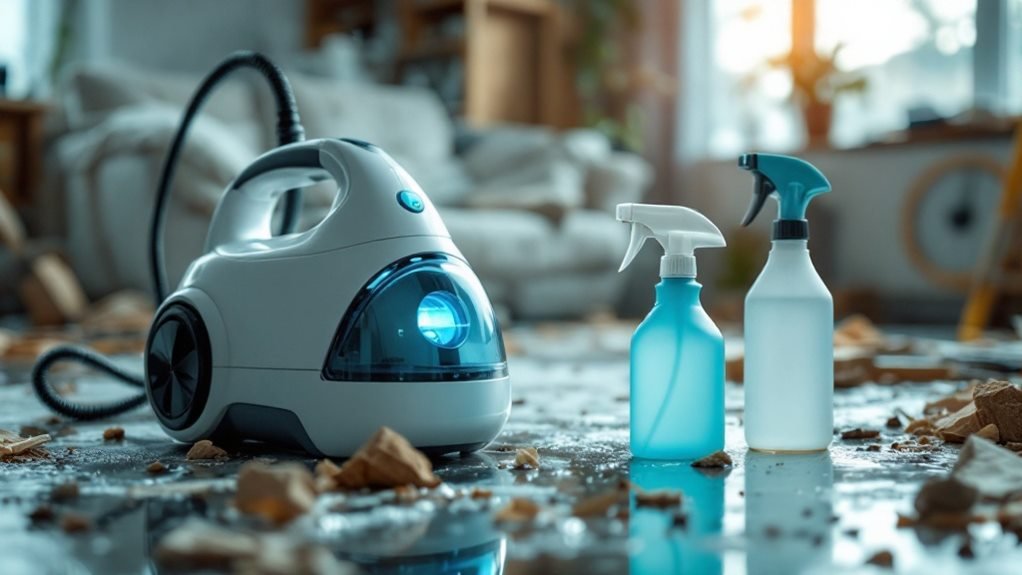
Sanitizing and disinfecting surfaces after water damage is essential to prevent mold growth and guarantee a safe environment. You wouldn't want to invite mold to your next dinner party, right? To effectively tackle the aftermath of water exposure, you'll need to arm yourself with the right sanitization techniques and disinfection processes.
First, grab your favorite disinfectants—make sure they're EPA-approved. These powerful solutions target harmful pathogens lurking in damp areas. Using a combination of spray bottles and mops, apply the disinfectant evenly across surfaces. For those hard-to-reach spots, consider using a fogger; it'll disperse the solution like a pro and leave no corner untouched.
Next up are sanitization tools like steam cleaners. They not only eliminate bacteria but additionally leave your surfaces looking spick and span—perfect for when house guests drop by unannounced. Remember to follow the manufacturer's guidelines for the best results.
Monitoring and Assessment Equipment
After you've taken steps to sanitize and disinfect your space, the next phase involves monitoring and evaluating the extent of the water damage. It's like being a detective, but instead of solving crimes, you're identifying moisture hiding in the shadows. That's where monitoring and assessment equipment come into play, and trust me, they're worth their weight in gold.
Here's what you'll want to take into account:
- Thermal Imaging Cameras: These nifty gadgets let you see temperature differences, helping you spot water leaks and damage that might be lurking beneath the surface. Who knew heat could be so revealing?
- Humidity Sensors: Keeping an eye on humidity levels is essential. Too much moisture can lead to mold, which is like that uninvited guest who overstays their welcome.
- Moisture Meters: Use these to measure the moisture content of various materials in your home. Think of them as the "wellness checks" for your walls and floors.
Benefits of Hiring Professionals
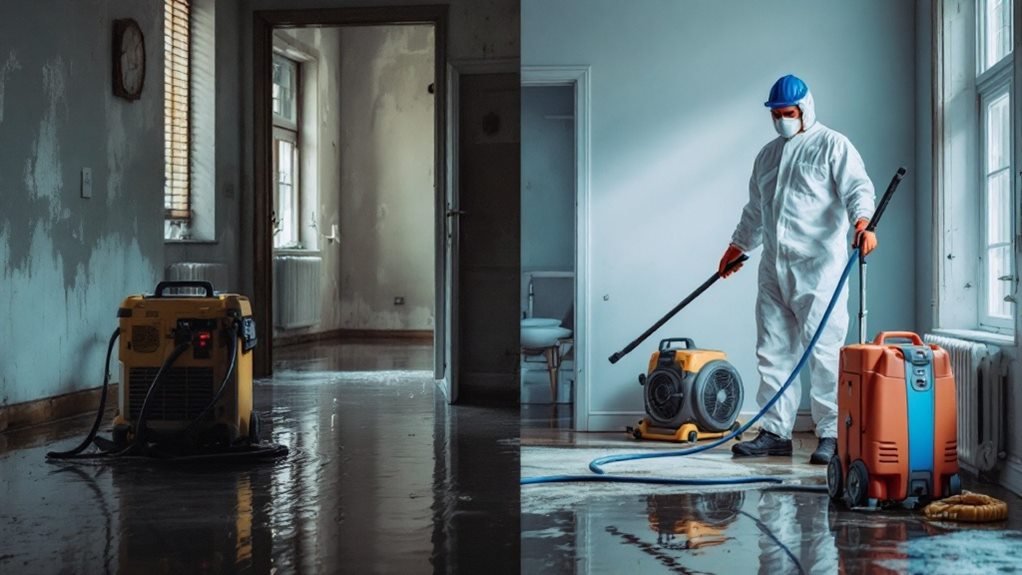
While tackling water damage on your own might seem like a cost-effective choice, hiring professionals can greatly improve the restoration process. Think of it this way: you're not just paying for expertise; you're investing in peace of mind. Professionals bring specialized equipment that can detect hidden moisture, preventing costly mold problems down the line.
When you weigh the cost comparison, DIY repairs often lead to more significant expenses because of mistakes or incomplete work. You might think you're saving money, but those "quick fixes" can turn into long-term headaches. Plus, many insurance policies cover professional restoration services, so you could end up with a smaller bill than expected.
Let's not forget the time factor. Professionals work efficiently, allowing you to get back to Netflix bingeing instead of mopping floors. They too know the ins and outs of insurance coverage, ensuring you maximize your claim. So, while the DIY route may appeal to your inner handyman, hiring experts is like swapping a rusty toolbox for a high-tech workshop—you're set up for success. It's a no-brainer, really!
Frequently Asked Questions
How Do I Choose a Water Damage Restoration Professional?
When choosing a water damage restoration professional, verify their credentials and ask about their restoration techniques. A qualified expert will have the right tools and expertise, ensuring your home's back to normal—minus the indoor swimming pool!
What Safety Precautions Should I Take During Restoration?
During restoration, wear protective gear like gloves and masks. Familiarize yourself with emergency procedures; you never know when a surprise may pop up. Safety first, or you might find yourself swimming in trouble!
Can I Use Household Tools for Water Damage Restoration?
They say, "A fool and his tools are soon parted." While household tools can help, their restoration effectiveness often falls short compared to professional equipment. You'll likely save time and hassle by opting for specialized gear.
How Long Does the Restoration Process Usually Take?
The restoration process can vary widely, depending on factors like damage severity and drying equipment used. Typically, it takes a few days to weeks. Remember, patience is key—don't rush a good drying!
Is Water Damage Covered by Homeowners Insurance?
You'll want to check your homeowners insurance policy, as water damage might be covered. Nevertheless, not all situations qualify, so read the fine print. Don't let a soggy situation drown your wallet!
Conclusion
In water damage restoration, professional equipment acts like a lighthouse guiding you through a storm. When you hire experts equipped with advanced tools, you guarantee that every hidden pocket of moisture is uncovered and dealt with efficiently. Just as a ship relies on its compass to navigate turbulent waters, you can trust these professionals to steer your restoration efforts toward a safe, thorough recovery. Investing in their expertise and equipment means safeguarding your property from further damage and guaranteeing a brighter, drier future.

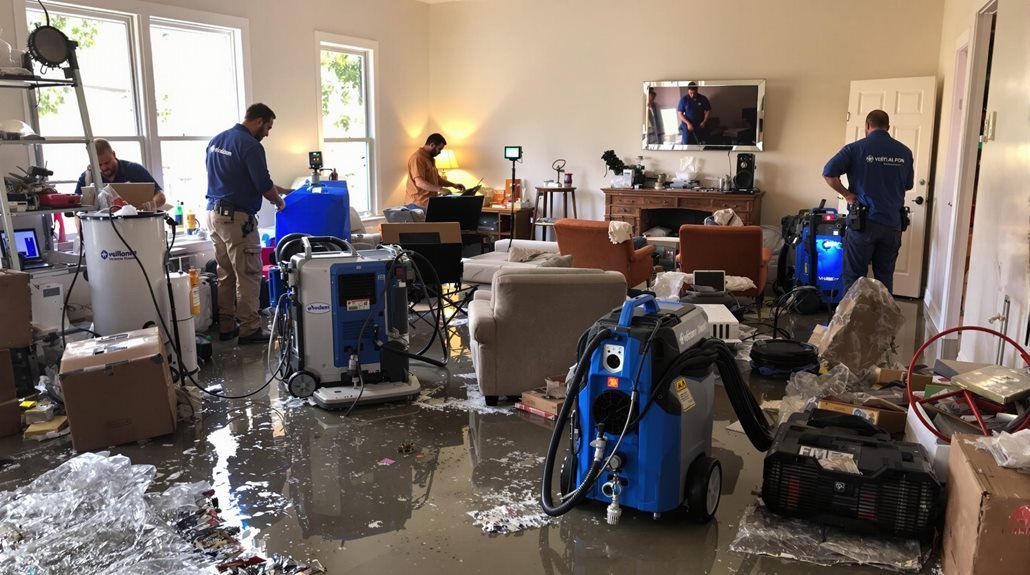
Recent Comments